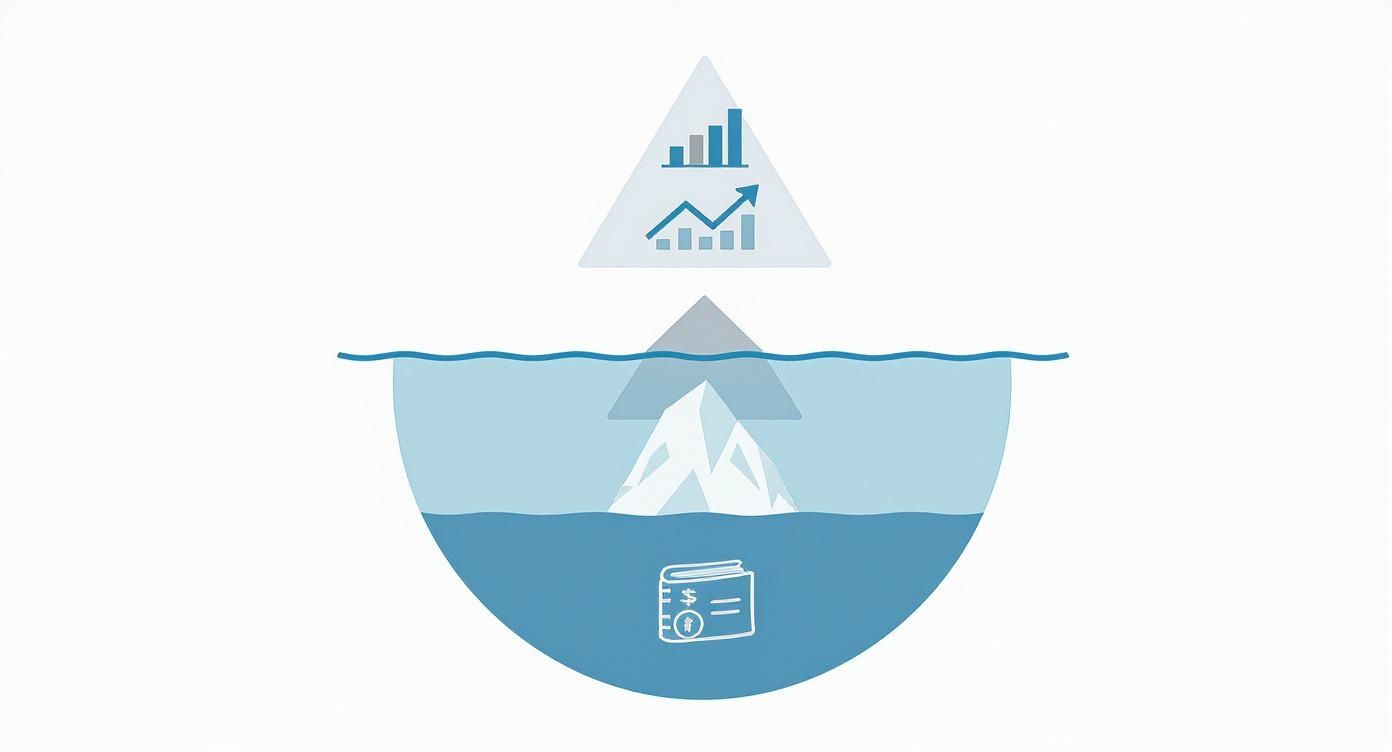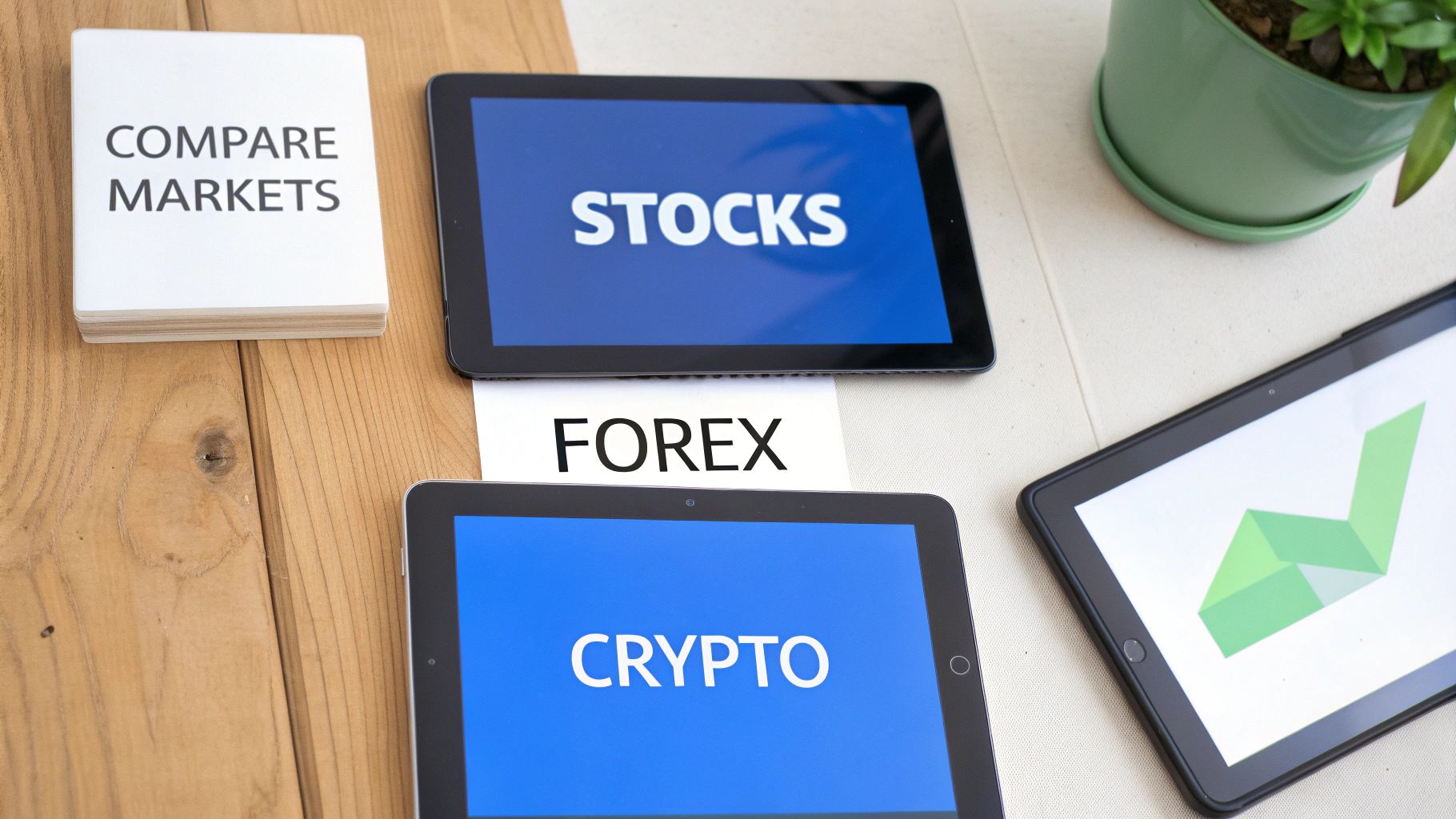What Is Market Depth and How to Read It
Think of the price you see on a chart as just the tip of the iceberg. It’s what everyone sees, the final result of a trade. But what’s lurking beneath the surface? That’s market depth—the vast, hidden structure of all the buy and sell orders waiting to be executed at different prices.
It’s the most direct, unfiltered look you can get into a market's real-time supply and demand.
Understanding Market Depth Beyond the Price Chart
Looking at a price chart alone is like watching a movie with the sound off. You see what’s happening, but you’re missing the full story. Market depth, usually shown in an order book, gives you x-ray vision into the market’s true intentions. It’s how you can start to anticipate price moves, gauge real liquidity, and stop trading blind.
This concept is closely tied to overall market health. If you want to go deeper, we have a whole guide on what market liquidity is and why it's so critical.
At its heart, market depth tells you how well an asset can handle large orders without the price going haywire. For example, a behemoth like Apple Inc. (AAPL) has incredible depth. You can throw massive orders at it, and the price barely flinches.
According to data from Nasdaq, it's not uncommon for top-tier stocks to have a depth exceeding 1 million shares at a single price level. The total order book can often represent over 5 million shares ready to trade.
This is what that data looks like in action. The order book visually stacks the bids (buy orders) and asks (sell orders) at every price point.
The screenshot above gives you a clear picture of the supply and demand battlefield. Buy orders (bids) are lined up on one side, and sell orders (asks) are on the other.
To make this even clearer, let's quickly break down the key pieces of the puzzle.
Key Components of Market Depth at a Glance
This table simplifies the core elements you'll see in any order book, helping you quickly understand what you're looking at.
| Component | What It Represents | Why It Matters for Traders |
|---|---|---|
| Bid Price | The highest price a buyer is willing to pay for an asset right now. | Shows the immediate demand. A high volume of bids can act as a "support" level for the price. |
| Ask Price | The lowest price a seller is willing to accept for an asset right now. | Shows the immediate supply. A large volume of asks can create a "resistance" level. |
| Bid Size | The total quantity of an asset that buyers want to purchase at a specific bid price. | Indicates the strength of demand at that price. Large bid sizes create "buy walls." |
| Ask Size | The total quantity of an asset that sellers want to offload at a specific ask price. | Indicates the strength of supply at that price. Large ask sizes create "sell walls." |
| Spread | The difference between the highest bid price and the lowest ask price. | A tight (small) spread usually means high liquidity and low volatility. A wide spread suggests the opposite. |
Seeing these components laid out visually in the order book is what gives you a real edge, allowing you to see support and resistance levels forming in real time.
The Anatomy of a Live Order Book
If you really want to understand market depth, you need to get familiar with the order book, sometimes called the Depth of Market (DOM). Forget the intimidating jargon for a second. Just picture a live, real-time tug-of-war between buyers and sellers.
On one side, you have the bids. These are all the pending buy orders, lined up and waiting. Think of this as the total visible demand for an asset at every single price point below the current market price.
On the other side, you've got the asks—all the pending sell orders that make up the available supply. The constant push and pull between these two forces is what makes the price tick up or down. A massive wall of bids can act as a support level, while a huge stack of asks can form a stubborn resistance ceiling.
Bids, Asks, and the Spread
Right in the middle of this battle is the bid-ask spread. It's simply the gap between the highest price a buyer is willing to pay (the highest bid) and the lowest price a seller is willing to accept (the lowest ask).
This little gap tells you a lot about a market's health. A tight spread usually means the market is liquid and efficient, so you can get in and out of a position easily without causing a big price swing. A wide spread, however, often points to lower liquidity and higher volatility, so you need to be more careful.
If you want to go deeper on this, our complete guide on how to read Level 2 data is the perfect next step.
The infographic below really drives home the point that a simple price chart is just the tip of the iceberg. The real action—the massive structure of buy and sell orders—is hidden underneath in the order book.

This visual is a great reminder that what you see on a standard chart is only a tiny fraction of the full market picture.
The image above shows a classic order book layout. You can clearly see the buy orders (bids) stacked on one side and the sell orders (asks) on the other, each with its own price and volume. This setup turns a chaotic flood of data into a clean map of market sentiment, showing you exactly where the real buying and selling pressure is building up.
Turning Order Book Data Into Actionable Insights

Looking at a raw order book is one thing. Actually using that data to find a strategic edge is a completely different ballgame. The real skill lies in spotting the patterns that tell you where the price might hit a snag or find some much-needed support. This is how you go from just watching the market to anticipating its next move.
Making sense of this raw information involves a process not unlike general data enrichment principles, where you're turning a flood of numbers into signals you can act on. Your goal is to find those big, chunky clusters of orders that have the power to shove the price around in the very near future.
Two of the biggest and most important patterns you'll want to get good at spotting are buy walls and sell walls.
Identifying Buy Walls and Sell Walls
Think of a buy wall as a massive defensive line in football. It’s either one gigantic buy order or a whole bunch of them stacked up at a single price level. This wall creates a temporary floor for the price. Why? Because the price can't drop any lower until every single one of those buy orders gets filled.
On the flip side, a sell wall is the exact opposite. It's a huge sell order, or a thick cluster of them, sitting at a specific price. This acts like a temporary ceiling of resistance, making it tough for the price to break through until all those sell orders are bought up.
These walls give you a live map of potential short-term support and resistance levels. The cool part is they are built on real supply and demand happening right now, not just lines drawn on a historical chart.
It's crucial to remember that these walls aren't set in stone. Big players can pull them in an instant—a tactic sometimes called "spoofing" to mess with market sentiment. Still, their presence gives you a valuable real-time snapshot of what traders are thinking.
Spotting a Lopsided Order Book
Beyond just individual walls, the overall balance—or imbalance—of the entire order book can give you powerful clues about market sentiment. When you see the book is clearly "lopsided," it means one side has way more volume than the other.
Here’s a quick guide to reading the imbalance:
- Heavily Skewed to Bids: If you see way more volume on the buy side (the bids), it points to strong buying pressure. This often signals short-term bullish feeling in the market, as plenty of buyers are lined up, ready to soak up any selling.
- Heavily Skewed to Asks: When the sell side (the asks) is stacked much higher, it’s a clear sign of heavy selling pressure. This usually suggests a bearish short-term outlook, with lots of sellers eager to get rid of their positions.
By getting a feel for these imbalances, you develop a much deeper understanding of market depth. It allows you to make more informed decisions based on the current dynamics of supply and demand, giving you a serious advantage over traders who are only staring at the price chart.
Why Market Depth Looks Different Across Assets

You can't just pull up an order book for a major stock like Apple and expect it to look anything like one for a brand-new cryptocurrency. It won't. Market depth is not a one-size-fits-all concept; it's shaped entirely by the asset being traded. Every market has its own unique fingerprint, and the order book is where you see it.
Several key factors are at play here, creating wildly different trading landscapes. Getting a feel for this context is absolutely essential. A trade that might shove a small-cap stock's price by 5% would barely make a ripple in a major forex pair.
Market Structure and Participants
The first big differentiator is the market's size and who's actually in it. A mature, massive market like foreign exchange (forex) runs 24/5 and is dominated by giants—think central banks and huge multinational corporations. This creates an ocean of deep, consistent liquidity.
On the flip side, the crypto market is much younger, fragmented across dozens of exchanges, and packed with individual retail traders. This often results in "thinner" order books with less volume waiting on either side, making them far more susceptible to sudden, sharp price swings.
The forex market is the classic example of extreme depth. For a major pair like EUR/USD, it's not uncommon to see order book depths clearing $1 billion at the best bid and ask prices. But look at a more exotic pair like USD/ZAR, and you might find less than $10 million available, making it a much more volatile playground. For a deeper dive into how this plays out in other markets, the Federal Reserve Bank of New York has some great insights on Treasury market depth.
Key Takeaway: The deeper the market, the more money it takes to move the price. This inherent stability makes deep markets like major forex pairs less vulnerable to the shockwaves of a single large trade compared to thinly traded assets.
Getting Market Depth to Work for You
Understanding the theory is one thing, but actually connecting it to your bottom line is what really matters. Analyzing market depth isn't some academic exercise; it’s a practical way to get a real-time edge. Traders turn the order book into a dynamic decision-making tool, but how they use it depends entirely on their goals.
For the fast-movers like scalpers and day traders, market depth is a goldmine for spotting immediate opportunities. They're constantly hunting for short-term imbalances between bids and asks. A sudden surge in buy orders could signal a quick upward pop in price—a perfect entry for a scalp. On the flip side, a rapidly growing sell wall might be their cue to get out before the price hits a brick wall.
Dodging Slippage on Big Orders
Traders who need to move serious volume are playing a different game: damage control. Trying to execute a massive order all at once can be a disaster. You'll chew through all the available shares at the best prices and be forced to accept progressively worse prices for the rest of your order. That costly price shift is called slippage.
To avoid this costly mistake, smart traders use the order book to break their large position into smaller, more manageable chunks. They can feed their orders into the market strategically, only placing them when there’s enough depth to absorb them without causing a major price disruption. This little bit of patience helps protect their profits by getting them an execution price as close to their target as possible.
Market depth gives traders with large positions the visibility they need to avoid tipping their hand. By gauging liquidity at different levels, they can work their orders discreetly and stop the market from moving against them because of their own actions.
Using Market Depth for Trade Confirmation
Perhaps the most powerful way to use market depth is as a final confirmation tool. It adds a crucial layer of confidence to signals you’re already getting from your charts and technical analysis. Think of it as the final sanity check before you pull the trigger.
Here’s how that looks in the real world:
- If a stock’s price is dropping toward a key support level on your chart, then look for a thick buy wall forming in the order book. That cluster of real-time demand adds powerful evidence that the support level is likely to hold.
- If you spot a breakout pattern taking shape, then check the order book for thinning resistance on the ask side. When you see fewer and fewer sell orders in the way, it suggests the path of least resistance is up, making a successful breakout much more likely.
- If the price is slamming into a major resistance line, then watch for a large sell wall to appear. This confirms heavy supply is sitting there, which could be a great signal to take profits or even consider a short position.
When you start integrating order book analysis into your routine, you’re no longer just trading based on what the price did in the past. You're making decisions based on the live, present-tense forces of supply and demand that are moving the market right now.
Unpacking a Few Common Questions About Market Depth
As you start digging into market depth, a few questions always seem to pop up. It's totally normal. Getting these sorted out is key to understanding what the order book is telling you—and what it isn't. Let's tackle some of the most frequent ones.
What's the Real Difference Between Level 1 and Level 2 Data?
Think of it like this: Level 1 data is just the headline. It’s the basic ticker info you see everywhere, showing the single best bid price and the single best ask price at that exact moment. It’s like seeing only the two people at the very front of a long line. You know a transaction is about to happen, but you have no idea how many people are waiting behind them.
Level 2 data, on the other hand, shows you the entire line. This is the good stuff, the core of market depth analysis. Instead of just the front of the line, you see the full order book—a ranked list of all the bids and asks stacked up at different price levels. This gives you a complete picture of the real supply and demand waiting in the wings.
Can You Actually Predict Price Moves with Market Depth?
Market depth isn't a crystal ball, but it’s an incredible tool for weighing probabilities. It’s a live, unfiltered snapshot of the supply and demand forces that are physically moving the price. When you spot huge buy or sell walls in the order book, you can anticipate potential zones of support and resistance with a lot more confidence.
A word of caution, though: big orders can be placed and pulled in the blink of an eye. Some traders use this tactic, known as "spoofing," to fake out the market. That's why market depth works best as a confirmation tool. Use it to add conviction to your primary analysis, not as a standalone fortune-teller.
How Does Liquidity Tie into Market Depth?
Liquidity and market depth are two sides of the same coin—they're deeply connected. A highly liquid market, like a major stock, will always have deep market depth. This means there's a thick wall of buy and sell orders clustered tightly around the current price. For traders, this is great; it means you can execute large trades without causing a massive price swing.
On the flip side, an illiquid market has what we call "thin" market depth. The order book looks sparse, with very few orders and wide gaps between the price levels. In these markets, even a small trade can send the price jumping dramatically, which ramps up both volatility and risk.
Ready to see the market's true intentions? ChartsWatcher provides the advanced order book and market depth tools you need to spot supply and demand imbalances in real time. Start making more informed trading decisions today.

